Interested in becoming a conservator? Fine art conservation is a rewarding career which brings you up close and personal with the history of art. Although it is attributed with the arts sector, conservation is also very much led by science and an understanding of chemistry. Conservators not only work to restore damage, but to prevent the deterioration of historically and sentimentally important pieces, this is achieved through the careful application of knowledge about different materials and their chemical compositions.
How do I get into conservation?
Many of our conservators have a background in fine art itself, whilst others specifically combined science and art subjects during their studies in pursuit of this career path. Conservation is a multi-faceted occupation which requires a mixture of scientific problem solving, historical knowledge, artistic skill, and above all a passion for preservation.
 Above: our administrative and conservation team discussing projects in our studio
Above: our administrative and conservation team discussing projects in our studio
Which areas of conservation are there?
There are numerous different conservation disciplines and types of conservator – all with their own unique skill sets. Different genres of artwork and antiques will have different requirements for preservation and approaches to cleaning or restoration work.
Listed below are some of the most common conservation disciplines you may come across:
- Easel Painting Conservation
- Wall Painting Conservation
- Book & Paper Conservation
- Furniture Conservation
- Textile Conservation
- Ceramics & Objects Conservation
- Stained Glass Conservation
- Stone Conservation
- Built Heritage Conservation
- Preventive Conservation
 Above: our conservator working on a large oil painting in our studio, midway through a varnish removal
Above: our conservator working on a large oil painting in our studio, midway through a varnish removal
There are also careers tangentially related to conservation which can incorporate a lot of conservation procedures and rationale:
- Conservation Technician
- Conservation Scientist
- Collections Care
- Pest Management
- Archaeologist
- Disaster Management
- Client Liaison
 Above: our conservator working on a Banksy mural in central London
Above: our conservator working on a Banksy mural in central London
How can I get into Conservation?
There are two main routes into becoming a conservator: Apprenticeships and Higher Education
Conservation apprenticeships
There is no set program for offering conservation apprenticeships as this is the more traditional route into conservation, which is steadily being replaced with higher education requirements for certain disciplines.
However, some sole practitioners do still train apprentices to work in their studios depending on their workload. Undertaking an apprenticeship is a more vocational way into the profession, learning the manual hands-on skills required by the different disciplines.
 Above: our conservators, all with different levels of experience, working together on modern and historic paintings
Above: our conservators, all with different levels of experience, working together on modern and historic paintings
Public bodies such as the National Trust offer positions such as Conservation Assistant (sometimes as trainee positions) which are more hands-on roles working with simple conservation treatments and preventive care; these often do not have a specific higher education requirement.
There are more formal apprenticeships that are offered by the Institute of Conservation (ICON) in collaboration with UK universities, however these are offered as part of degree programs.
 Above: one of our interns working on a torn oil painting canvas in our studio
Above: one of our interns working on a torn oil painting canvas in our studio
Conservation in higher education
There are a couple of undergraduate degree programs in more general conservation offered by the University of Lincoln, Cardiff University and City & Guilds, University of London. All of these courses prepare their students with a strong knowledge of conservation principles before they can then go on to specialise in their chosen discipline.
 Above: our ICON accredited paper conservator working on a miniature watercolour portrait
Above: our ICON accredited paper conservator working on a miniature watercolour portrait
The most common route into conservation in the UK is completing a Master’s Degree or graduate diploma relevant to your chosen discipline.
Conservators have a broad range of backgrounds, from artists to historians to scientists, all of whom bring valuable insight to the field. Before applying to degree programs, many people talk to conservators, visit conservation studios or, if able, get a voluntary placement within a studio.
 Above: our conservator retouching a painting (left) and photographing for professional documentation (right)
Above: our conservator retouching a painting (left) and photographing for professional documentation (right)
There are numerous different MA and graduate diploma programs available in the UK to suit everyone. Since conservation is such a hands-on career, many conservators undertake work placements and internships during their training to improve and develop their skills. These work placements can be in private studios, museums, galleries, public trusts or with conservators who are sole practitioners.
Information about all the different available courses can be found on the ICON website by clicking here
 Above: our interns working on conservation projects in our studio
Above: our interns working on conservation projects in our studio
Do you offer conservation internships?
At Fine Art Restoration Company we pride ourselves on passing on the knowledge and experience of our experts to the next generation of conservators. Every summer we run an internship programme for those on courses pursuing conservation, as well as anyone with relevant experience or enthusiasm.
Sophie is one of our recent interns, she would like to share her experience with you to give an idea of what you might expect from such a placement in a restoration studio with private clients.
Sophie’s Conservation Internship Experience
My name is Sophie and from September-December 2020 I was a conservation intern at Fine Art Restoration Company.
Having finished my MA in easel painting conservation from Northumbria University at the start of the COVID-19 Pandemic, I was keen to gain practical, hands-on experience in a studio environment.
 Above: Sophie retouching a large oil painting in our studio during her internship
Above: Sophie retouching a large oil painting in our studio during her internship
I had previously undertaken placements with the National Trust and local museums, but being offered the chance to work in a private studio for an extended period of time really helped me put my skills into practice and I feel very lucky to have been given the opportunity.
I did my internship alongside two other graduate painting conservators, who I shared our provided accommodation with. Not only did this foster a pleasant, collegiate environment in the studio but also made the prospect of moving to a new city for a few months a lot less daunting!
 Above: Sophie performing a heat treatment to stabilise a paint layer on an oil painting
Above: Sophie performing a heat treatment to stabilise a paint layer on an oil painting
My Responsibilities
As an intern, under supervision of the paintings conservators, my main responsibility was carrying out a variety of treatments on paintings ranging from 17th Century works to contemporary pieces. Having the supervision of more experienced conservators really helped to build my confidence as I developed my practical skills and experience working with different sorts of paintings and problems. As well as carrying out treatments, I was also involved with the day to day activities of the studio which included:
- Updating the office team with treatment progress for them to then communicate with the client
- Professionally wrapping paintings, as well as other artworks and antiques
- Remedial frame conservation treatments
- Preparing adhesives, solvents, gels and varnishes for use during treatments
- Maintaining an orderly studio with an understanding of best practices
 Above: Sophie working on an oil painting in our studio during her internship
Above: Sophie working on an oil painting in our studio during her internship
My favourite restoration
My favourite restoration treatment was that of an 18th Century portrait of a young boy and a dog, which required several different interventions. Having spent a lot of time researching 18th Century British painting whilst at University, it was great to get hands-on experience with this painting and to be able to confidently carry out all aspects of treatment myself.
 Above: Sophie’s restoration of an 18th century portrait, including varnish removal (seen halfway on the left), before and after (centre) and a detail of the original damaged canvas (right)
Above: Sophie’s restoration of an 18th century portrait, including varnish removal (seen halfway on the left), before and after (centre) and a detail of the original damaged canvas (right)
Treatments I carried out included: consolidation, verso-cleaning, surface cleaning, thread-to-thread tear mending, correcting planar deformations, varnish removal, aged retouching removal, retouching and varnishing.
What I gained from the internship
The main thing which I gained from my internship is confidence. Both in carrying out practical treatments and identifying areas of concern in different paintings. Through working in the busy private studio environment, my practical skills developed quickly from being involved with a range of diverse and challenging projects.
The chance to work on a wide range of oil, acrylic and mixed media paintings, as well as paintings on different supports really supplemented my experience and helped to develop and refine my portfolio. I also benefited from the knowledge and experience of more senior conservators, which exposed me to new materials and techniques as well as developing my own decision-making capability.
 Above: Sophie during her internship consolidating an unstable oil painting
Above: Sophie during her internship consolidating an unstable oil painting
Get in touch with our team
Please get in touch with our team if you would like to apply for an upcoming internship position, or if you have any queries related to the study of conservation.
You can contact us by emailing [email protected] or calling us on 0207 112 7576.

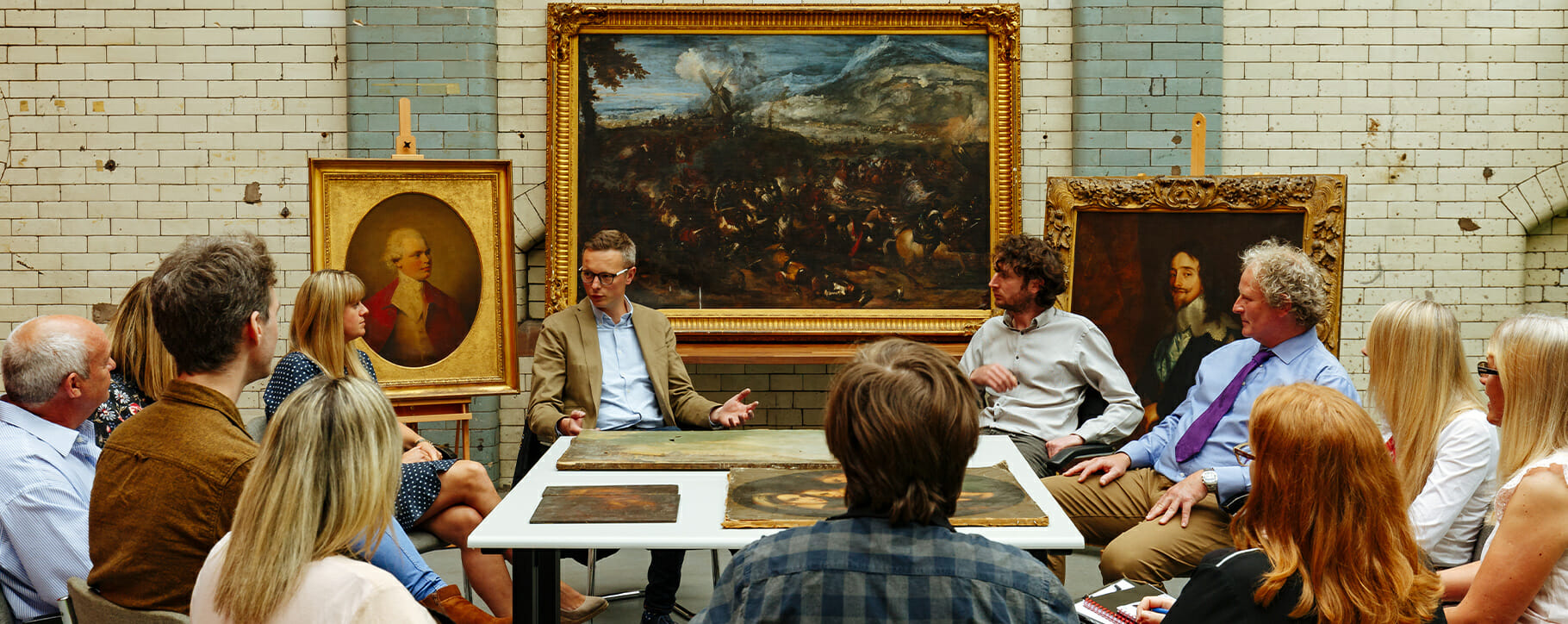 Above: our administrative and conservation team discussing projects in our studio
Above: our administrative and conservation team discussing projects in our studio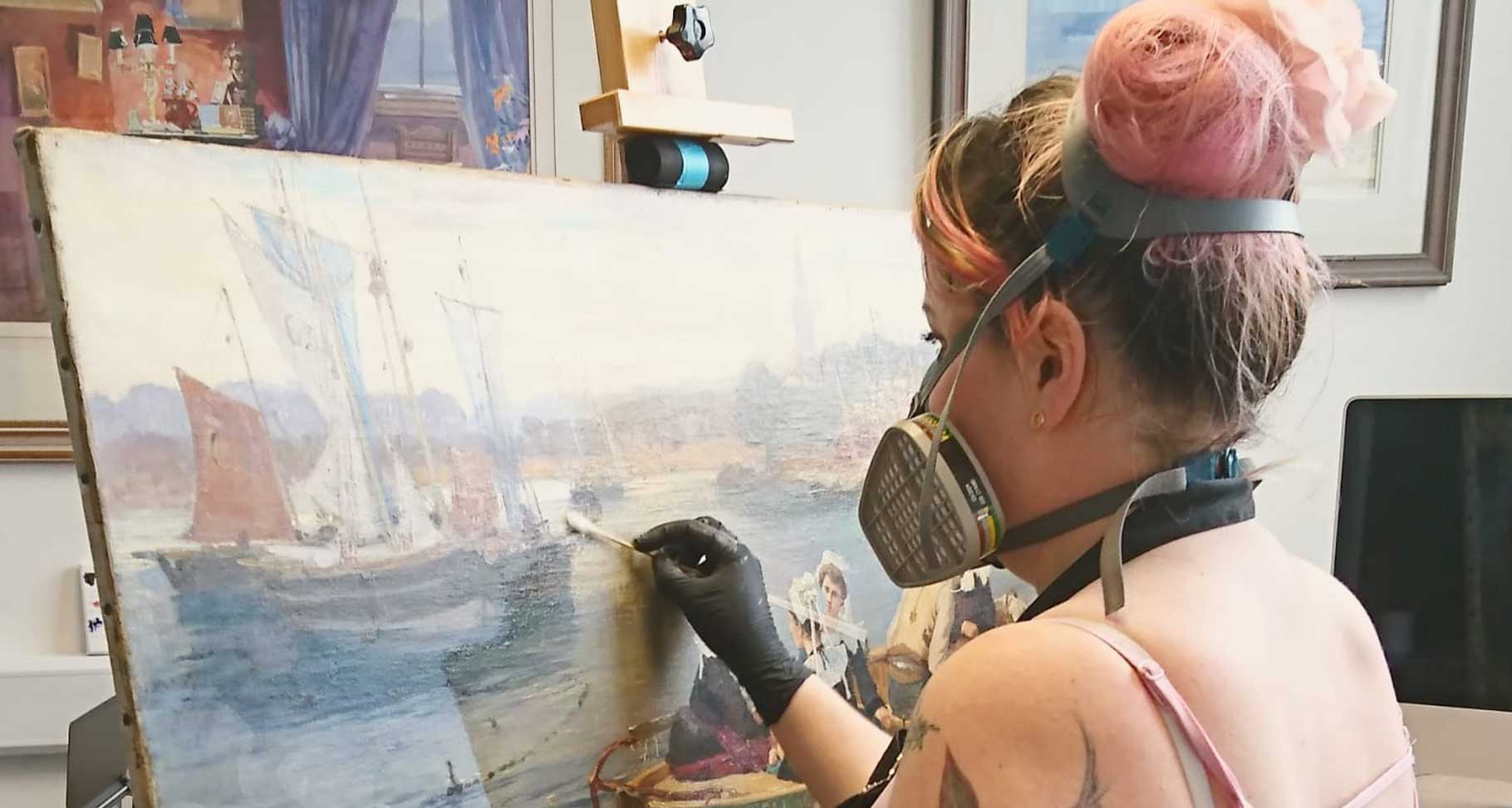 Above: our conservator working on a large oil painting in our studio, midway through a varnish removal
Above: our conservator working on a large oil painting in our studio, midway through a varnish removal Above: our conservator working on a Banksy mural in central London
Above: our conservator working on a Banksy mural in central London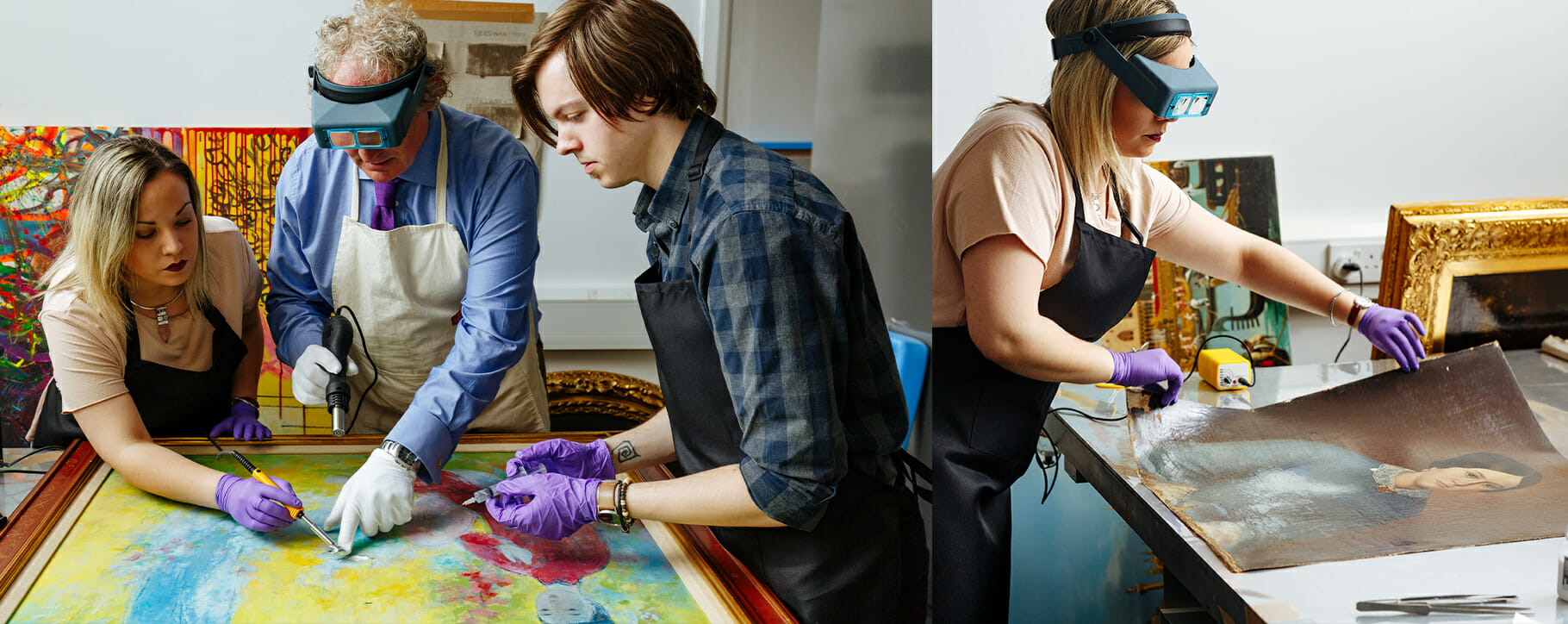 Above: our conservators, all with different levels of experience, working together on modern and historic paintings
Above: our conservators, all with different levels of experience, working together on modern and historic paintings 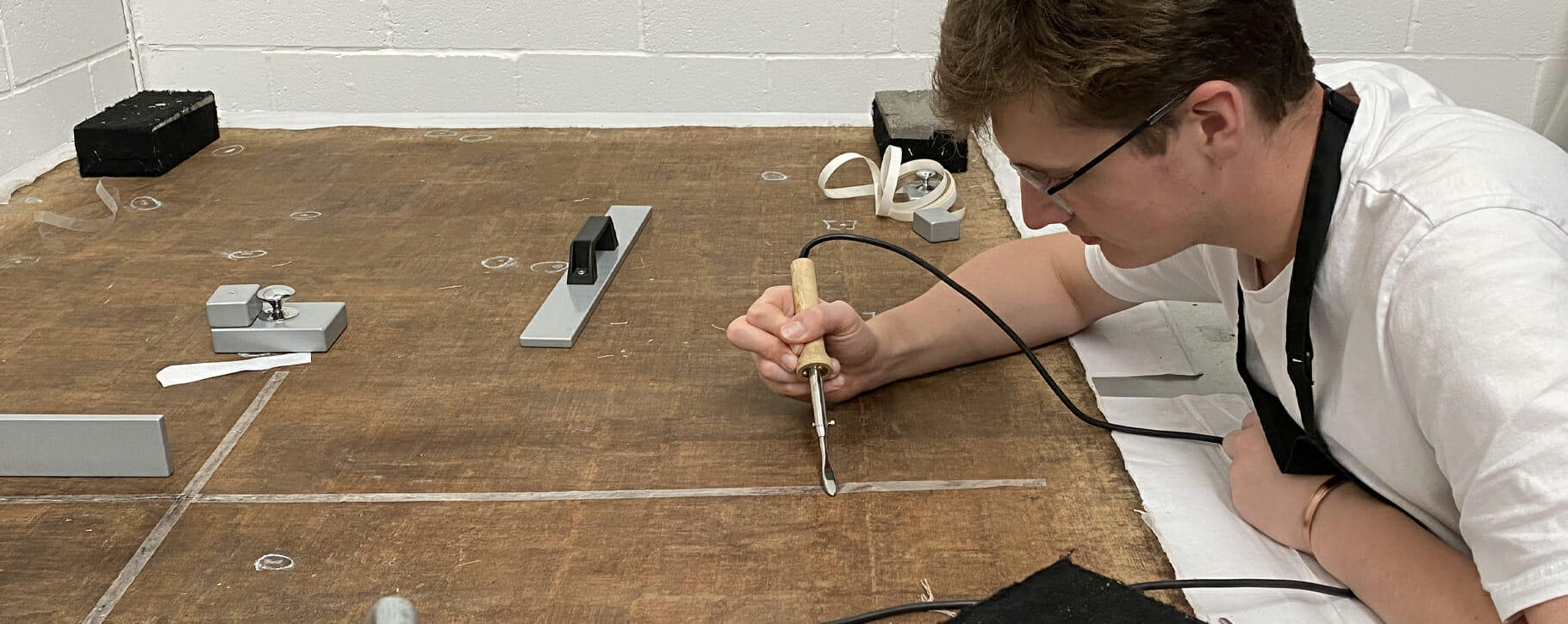 Above: one of our interns working on a torn oil painting canvas in our studio
Above: one of our interns working on a torn oil painting canvas in our studio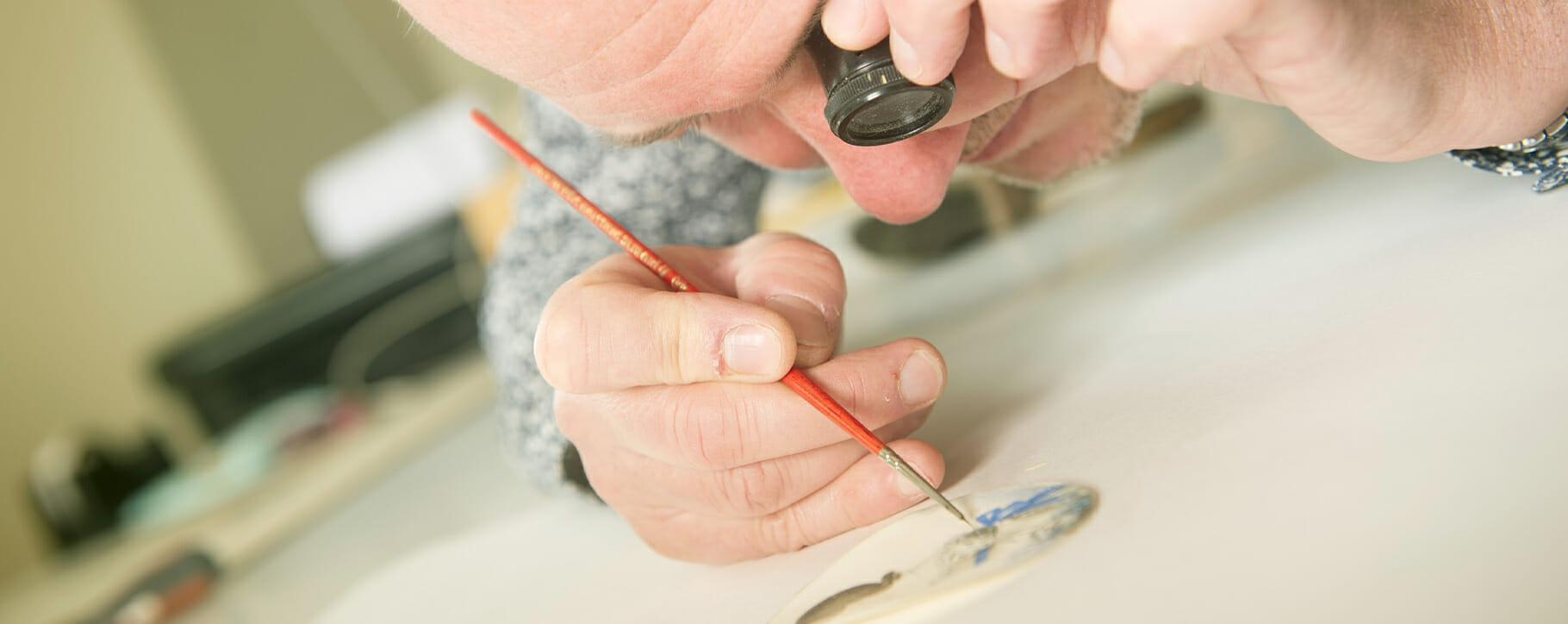 Above: our ICON accredited paper conservator working on a miniature watercolour portrait
Above: our ICON accredited paper conservator working on a miniature watercolour portrait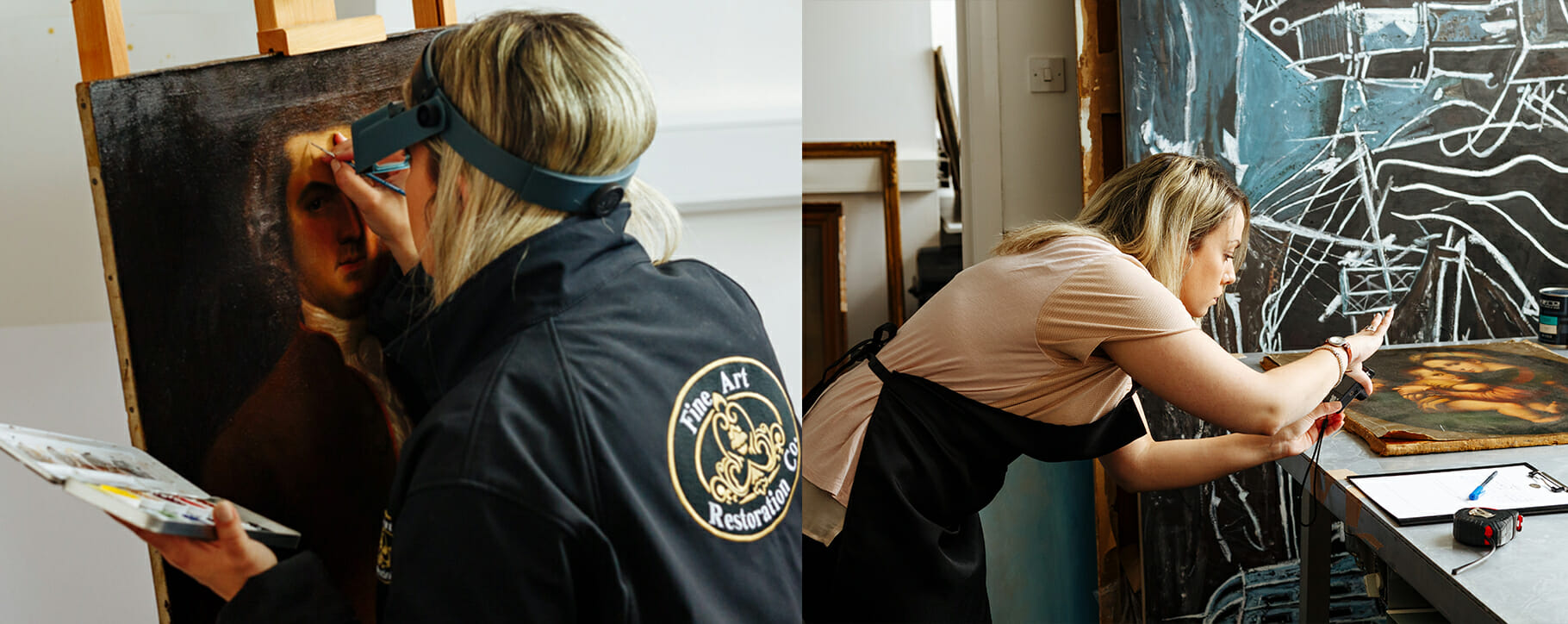 Above: our conservator retouching a painting (left) and photographing for professional documentation (right)
Above: our conservator retouching a painting (left) and photographing for professional documentation (right)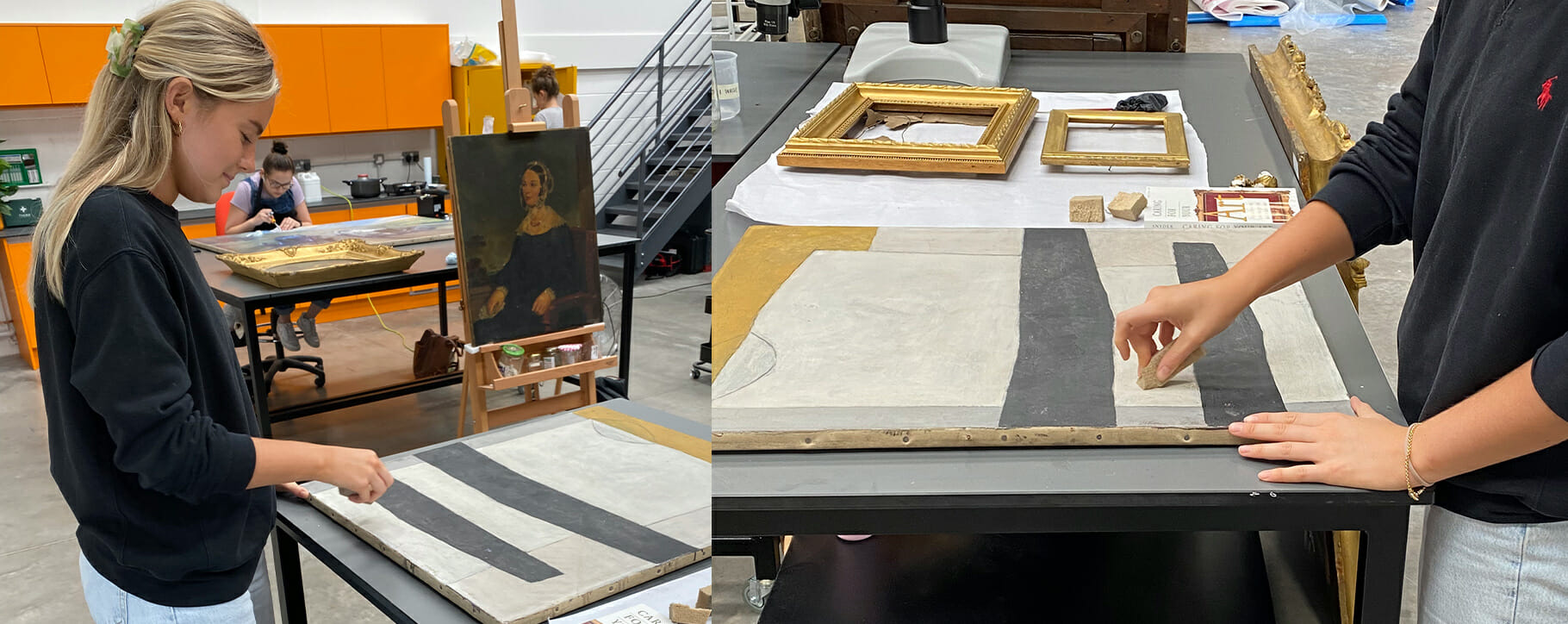 Above: our interns working on conservation projects in our studio
Above: our interns working on conservation projects in our studio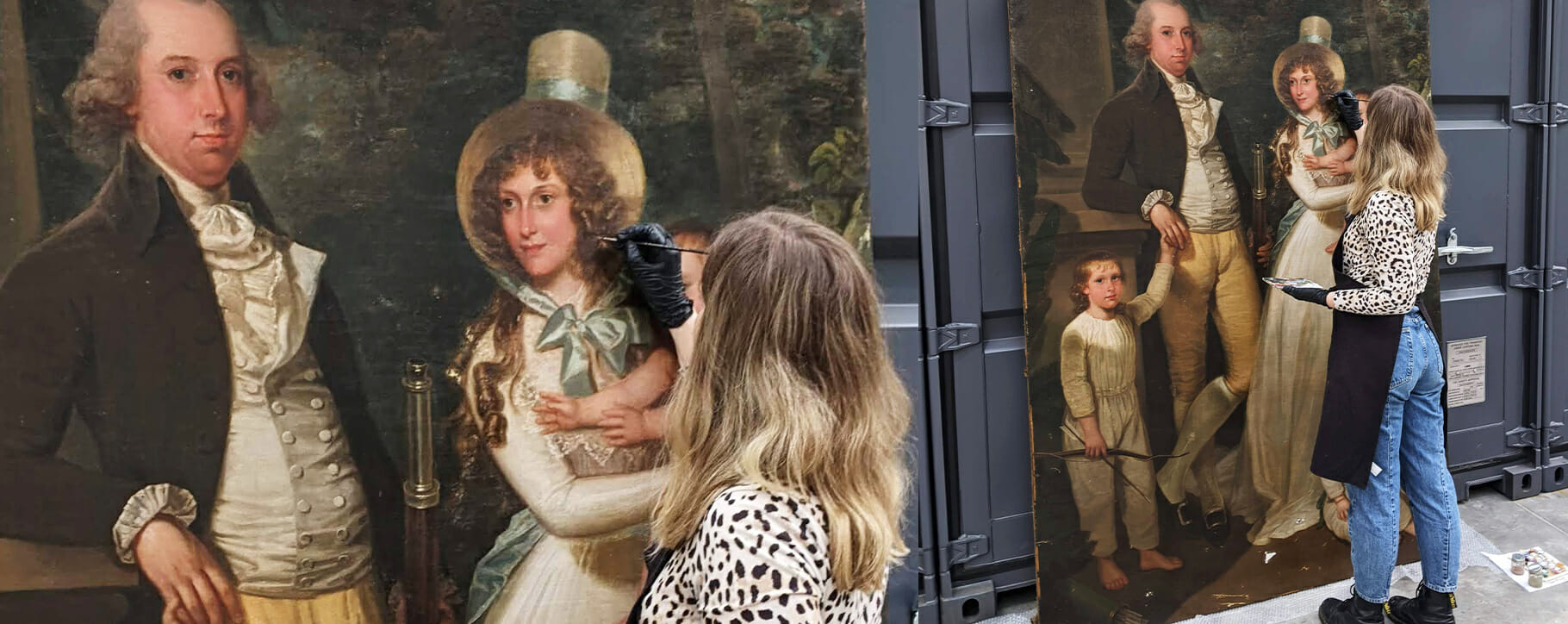 Above: Sophie retouching a large oil painting in our studio during her internship
Above: Sophie retouching a large oil painting in our studio during her internship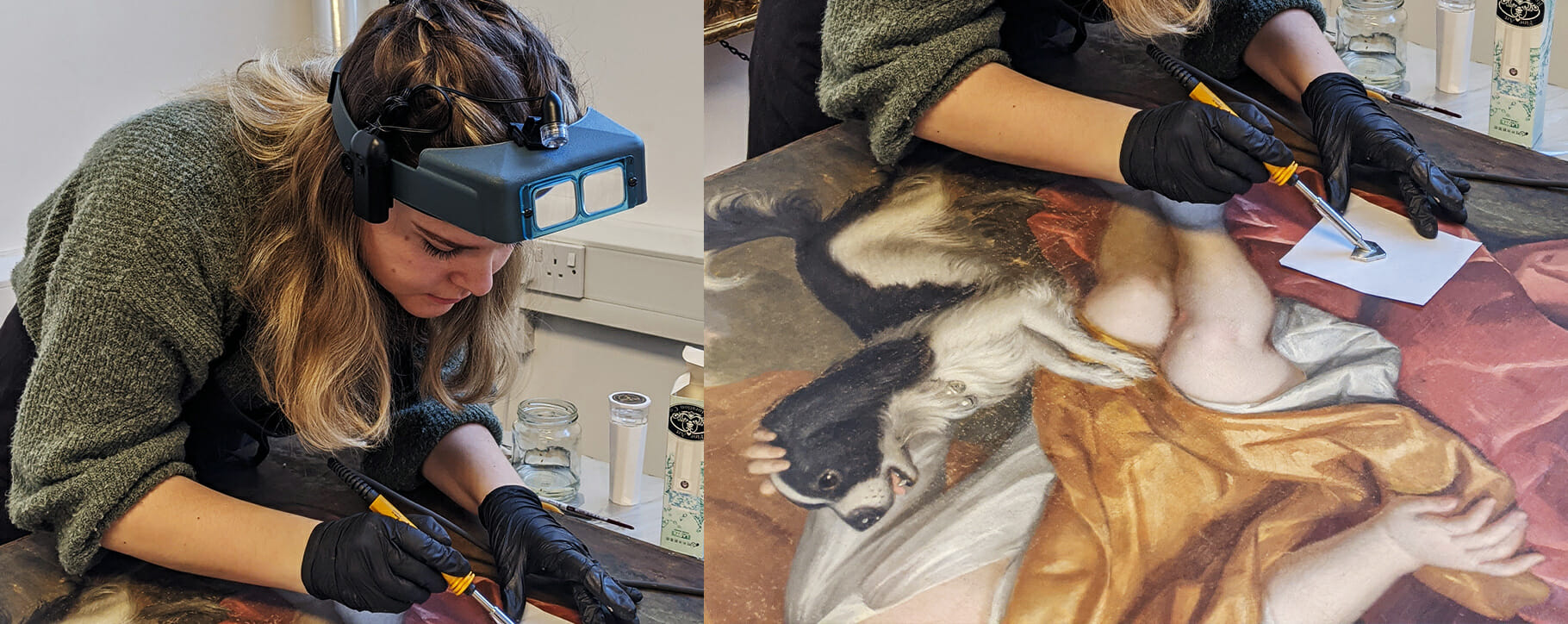 Above: Sophie performing a heat treatment to stabilise a paint layer on an oil painting
Above: Sophie performing a heat treatment to stabilise a paint layer on an oil painting Above: Sophie working on an oil painting in our studio during her internship
Above: Sophie working on an oil painting in our studio during her internship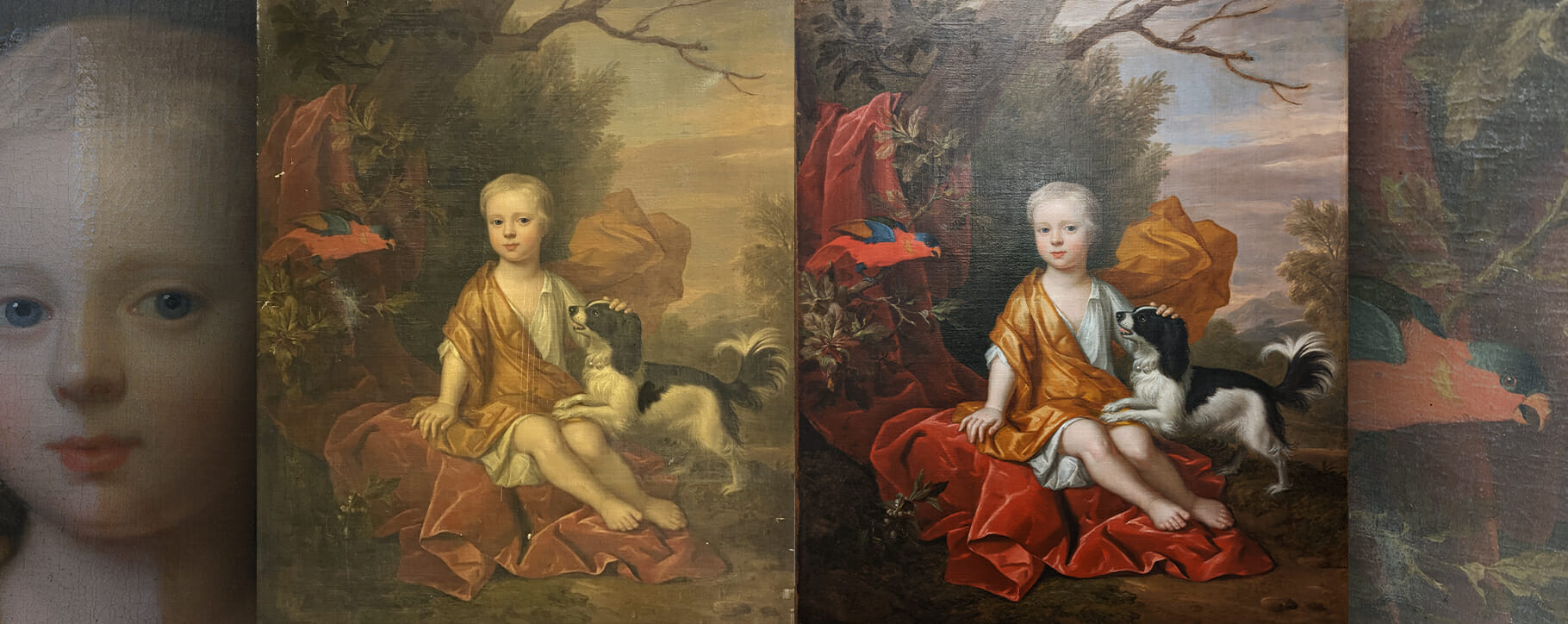 Above: Sophie’s restoration of an 18th century portrait, including varnish removal (seen halfway on the left), before and after (centre) and a detail of the original damaged canvas (right)
Above: Sophie’s restoration of an 18th century portrait, including varnish removal (seen halfway on the left), before and after (centre) and a detail of the original damaged canvas (right) Above: Sophie during her internship consolidating an unstable oil painting
Above: Sophie during her internship consolidating an unstable oil painting




